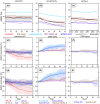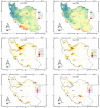Green Closed-Loop Supply Chain Network Design During the Coronavirus (COVID-19) Pandemic: a Case Study in the Iranian Automotive Industry
- PMID: 36540109
- PMCID: PMC9756749
- DOI: 10.1007/s10666-022-09863-0
Green Closed-Loop Supply Chain Network Design During the Coronavirus (COVID-19) Pandemic: a Case Study in the Iranian Automotive Industry
Abstract
This paper presents a new mathematical model of the green closed-loop supply chain network (GCLSCN) during the COVID-19 pandemic. The suggested model can explain the trade-offs between environmental (minimizing CO2 emissions) and economic (minimizing total costs) aspects during the COVID-19 outbreak. Considering the guidelines for hygiene during the outbreak helps us design a new sustainable hygiene supply chain (SC). This model is sensitive to the cost structure. The cost includes two parts: the normal cost without considering the coronavirus pandemic and the cost with considering coronavirus. The economic novelty aspect of this paper is the hygiene costs. It includes disinfection and sanitizer costs, personal protective equipment (PPE) costs, COVID-19 tests, education, medicines, vaccines, and vaccination costs. This paper presents a multi-objective mixed-integer programming (MOMIP) problem for designing a GCLSCN during the pandemic. The optimization procedure uses the scalarization approach, namely the weighted sum method (WSM). The computational optimization process is conducted through Lingo software. Due to the recency of the COVID-19 pandemic, there are still many research gaps. Our contributions to this research are as follows: (i) designed a model of the green supply chain (GSC) and showed the better trade-offs between economic and environmental aspects during the COVID-19 pandemic and lockdowns, (ii) designed the hygiene supply chain, (iii) proposed the new indicators of economic aspects during the COVID-19 outbreak, and (iv) have found the positive (reducing CO2 emissions) and negative (increase in costs) impacts of COVID-19 and lockdowns. Therefore, this study designed a new hygiene model to fill this gap for the COVID-19 condition disaster. The findings of the proposed network illustrate the SC has become greener during the COVID-19 pandemic. The total cost of the network was increased during the COVID-19 pandemic, but the lockdowns had direct positive effects on emissions and air quality.
Keywords: CO2 emissions; Lockdowns; Logistic network; Multi-objective optimization; Supply chain management; Weighted sum method.
© The Author(s), under exclusive licence to Springer Nature Switzerland AG 2022, Springer Nature or its licensor (e.g. a society or other partner) holds exclusive rights to this article under a publishing agreement with the author(s) or other rightsholder(s); author self-archiving of the accepted manuscript version of this article is solely governed by the terms of such publishing agreement and applicable law.
Conflict of interest statement
Competing InterestsThe authors declare no competing interests.
Figures















References
-
- ECDC (2020). An overview of the rapid test situation for COVID-19 diagnosis in the EU/EEA.
-
- Farooq MU, Hussain A, Masood T, Habib MS. Supply chain operations management in pandemics: A state-of-the-art review inspired by COVID-19. Sustainability. 2021;13(5):2504. doi: 10.3390/su13052504. - DOI
-
- Končar J, Grubor A, Marić R, Vučenović S, Vukmirović G. Setbacks to IoT implementation in the function of FMCG supply chain sustainability during COVID-19 pandemic. Sustainability. 2020;12(18):7391. doi: 10.3390/su12187391. - DOI
-
- Chiu CY, Cheng CY, Wu TY. Integrated operational model of green closed-loop supply chain. Sustainability. 2021;13(11):6041. doi: 10.3390/su13116041. - DOI
LinkOut - more resources
Full Text Sources
Research Materials
Miscellaneous
